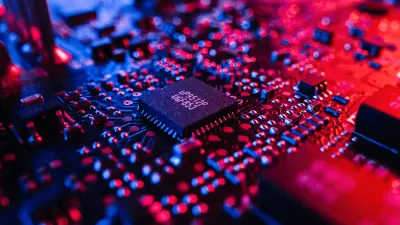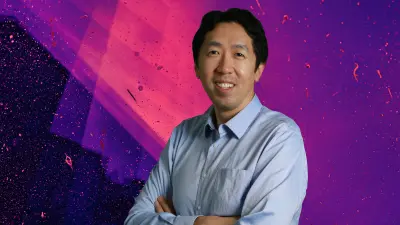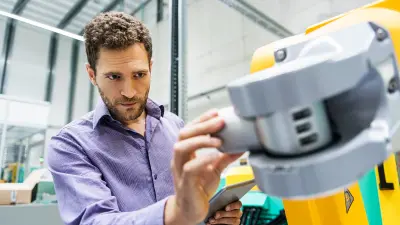How artificial intelligence is transforming the industry
In dialogue with the AI expert and CEO of Landing AI

2021-07-29
Artificial intelligence (AI) is becoming more and more important for the industry. Yet, many companies still do not know how to utilize this technology. Andrew Ng, expert in AI, explains what are the possibilities that AI already offers now and how we can properly leverage this potential.
It was almost ten years ago when Andrew Ng made a breakthrough in the field of artificial intelligence (AI) — with cat pictures. At the time, he was professor of computer science at Stanford University in the U.S. and, together with two Google associates, had built a computer system consisting of approximately 16,000 processors. The team fed this system image data until it had taught itself to distinguish cats from people in photographs. The project — Google Brain — made headlines around the world and became the heart of Google’s AI division of the same name, which Andrew Ng then headed.
He later co-founded Coursera, one of the world’s leading providers of massive open online courses. Ng is now CEO of Landing AI, a company he founded. It helps other companies implement industrial AI and provides related solutions. Ng’s enthusiasm is palpable when he talks about artificial intelligence: “AI is the new electricity,” he exclaims. “A hundred years ago, electricity transformed countless industries; 20 years ago the Internet did, too. Artificial intelligence is about to do the same.”
“AI is the new electricity.”
The next AI wave is already beginning
What Ng means by these statements becomes clearer when we take a look at history. A hundred years ago, as the rate of electrification increased, many entrepreneurs recognized the transformative power of electricity, but did not know exactly how to utilize it in their day-to-day business. Today, artificial intelligence presents companies with a similar challenge. “AI has already transformed the software internet industry. Companies like Google, Facebook, or Amazon use it very effectively. Currently, the next wave of AI is beginning,” says Ng. This will also transform all other industries, ranging from manufacturing to agriculture and from logistics to healthcare. “AI is not a point solution, it’s actually a much broader transformative impact. But I observe that many CEOs still struggle to understand this,” explains Ng. To harness the potential of AI, companies need to first understand what current AI systems can, and cannot, do.

What are the current capabilities of AI?
Artificial intelligence is broadly divided into two stages of development: artificial narrow intelligence (ANI) and the much more complex artificial general intelligence (AGI). All AI systems that are currently available are ANI. This includes systems such as voice assistants or self-driving cars that may seem quite sophisticated. “Almost all of AI’s recent progress is through that type, in which some input data A is used to quickly generate some simple response B. The technical term for building this algorithm is ‘supervised learning,’” states Ng. Such AI systems are only suitable for areas of activity that have clear boundaries, such as chatbots that draw on databases of typical questions and answers on a particular topic.
Ng has the following rule of thumb for people to get an idea of what tasks AI technologies can handle in the meantime: “If a typical person can do a mental task with less than one second of thought, we can probably automate it using ANI either now or in the near future.” On the other hand, artificial general intelligence does not yet exist. It is only considered to have been achieved when AI systems are capable of solving intellectual tasks that are comparable to human cognition. An example of this would be a robot that can play chess, go grocery shopping, and hold a conversation on topics chosen at random — seamlessly one after the other like a human. We still have a long way to go: According to Ng, “there might be breakthroughs that make higher levels of artificial intelligence possible, but there is still no clear path yet to this goal.”
“If a typical person can do a mental task with less than one second of thought, we can probably automate it.”
AI makes automation easier

It means that for now, robots that can think like humans will remain in the realm of science fiction. Nevertheless, artificial intelligence can already be used in many areas, such as manufacturing. “AI is automation on steroids,” explains Ng. “Take, for example, the visual quality control of smartphones. A few years ago, humans had to inspect products for scratches; machines couldn’t do that back then. Now we can have AI image processing systems do this task in an automated, systematic, and reliable way.”
Artificial intelligence also helps calculate fuel-efficient routes in logistics, make data-driven demand forecasts for supply chain management, and plan the optimal time for maintenance work on manufacturing machines. “If your industry generates a large amount of data, there is a good chance that AI can be used to transform that data into value,” states Ng. Artificial intelligence is also increasingly being used in connectivity for machines and devices. And it creates an Artificial Intelligence of Things (AIoT) that not only collects data, but also analyzes it directly at the source, drawing conclusions from it in real time. For example, AIoT sensors help optimize a plant’s energy consumption or manufacturing processes.
How can the industry utilize AI correctly?
Many industrial companies are still struggling however, when it comes to integrating artificial intelligence into manufacturing. They usually do not have huge databases through which AI models could make rapid progress, in contrast to Internet corporations from Silicon Valley. “In addition, each manufacturing plant has its own design and requires tailored AI solutions,” says Ng. A company with several thousand manufacturing plants needs a corresponding number of AI models. To create these, in turn, AI experts — of which there are currently too few — are needed. Ng sees the solution to these challenges in AI platforms and software tools that allow available manufacturing and IT experts in companies to create their own AI models.
Yet, he cautions against harboring high expectations: “Even when a project successfully completes a proof of concept demo, there is still a massive amount of work — including software to be written — to take the AI system to production.” That is why he recommends creating the position of Chief Artificial Intelligence Officer (CAIO) in companies: “The benefit is having someone who makes sure AI gets applied across silos. A dedicated AI team also has a higher chance of attracting AI talent and maintaining standards.” Companies should embrace it in time given the transformative power of AI. After all, according to Ng, just as electricity changed many things a hundred years ago, artificial intelligence will be an integral part of everyday manufacturing in the future.
Profile

Andrew Ng (45)
Expert in AI and CEO of Landing AI
“AI is getting in more and more industries. It will improve countless lives and create massive economic growth.”
Andrew Ng grew up in Hong Kong and Singapore. He studied computer science in the U.S., earning an undergraduate degree from Carnegie Mellon University in Pittsburgh and then a master’s degree from the Massachusetts Institute of Technology in Cambridge in 1998. Five years later, he received his PhD from the University of California, Berkeley (USA), with his thesis dealing with reinforcement learning. He went on to work as an assistant professor at Stanford University in the U.S. on artificial intelligence and supervised various AI research projects. He was one of the leaders of the Google Brain project starting in 2011, and in 2014 he moved to Baidu, the Chinese technology company, where he served as vice president and chief scientist of the AI group. In 2012, he also co-founded the online platform Coursera. Since 2017, Andrew Ng has acted as CEO of Landing AI, a company he founded to help customers implement AI-based visual inspection solutions using an end-to-end MLOps (Machine Learning Operations) platform. In addition, he is adjunct professor at Stanford University.
Summary
Artificial intelligence is penetrating more and more industries, Andrew Ng says. Current AI systems are operating within narrow boundaries in technologies, but they are still critical drivers of automation. Companies should look at the transformative potential of AI and consider it in their strategy.


